Contents:
The 1906 Indian Head Penny is a one-cent coin minted by the United States during the early 20th century. It belongs to the Indian Head cent series (1859–1909), designed by James B. Longacre, the Chief Engraver of the U.S. Mint at the time.
But how much is a 1906 penny worth, and how can you identify the coin? You’ll know it in this article.
Feature | Details |
Year | 1906 |
Type | Indian Head Cent |
Designer | James B. Longacre |
Composition | 95% copper, 5% tin and zinc |
Diameter | 19.05 mm |
Weight | 3.11 grams |
Mint Location | Philadelphia only (1906 Indian Head penny no mint mark) |
Mintage | 96,020,530 |
History Exploration
The Indian Head cent series was introduced in 1859 and minted until 1909, when it was replaced by the Lincoln cent. The 1906 issue is among the final years of this series. It was produced during a period of American industrial expansion and rising national identity.
Designed by James B. Longacre, the Indian Head cent aimed to symbolize Liberty in a way that reflected uniquely American imagery.
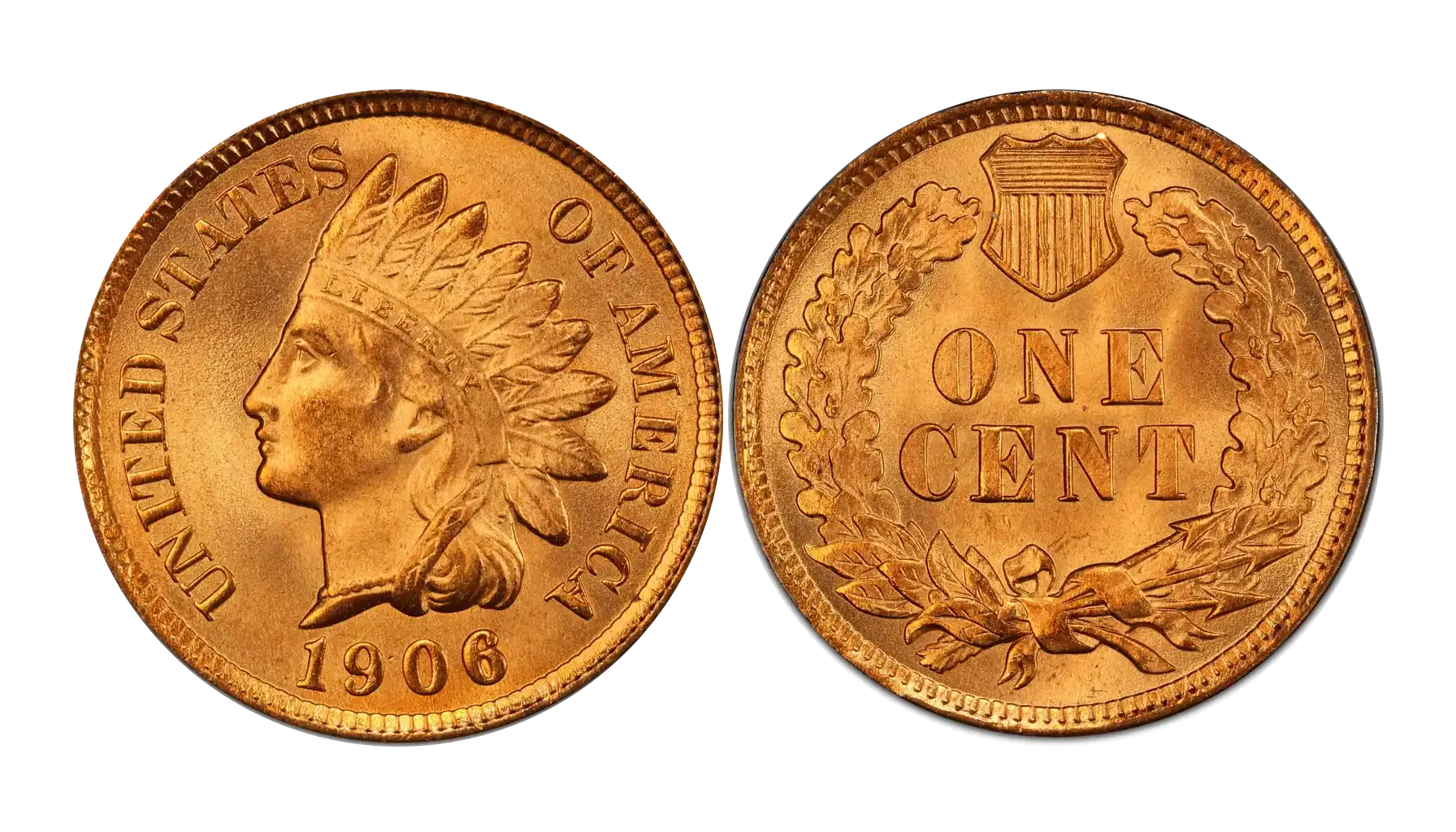
By 1906, over 96 million coins were struck — one of the highest mintages of the series, reflecting increased demand due to economic growth.
It was struck only at the Philadelphia Mint, which at the time was the sole producer of this denomination.
The 1906 US penny does not contain any silver. Instead, it is made from a bronze alloy composed of 95% copper and 5% tin and zinc. This composition was standard for U.S. one-cent coins from 1864 through the early 1960s. The coin weighs 3.11 grams and measures 19.05 millimeters in diameter.
Although some might assume older coins contain precious metals, the Indian Head cents were never struck in silver. They are copper-based and non-magnetic, with no intrinsic silver value.
Their 1906 Indian penny value today depends entirely on numismatic factors like condition, rarity, and color (brown, red-brown, or red). If you're looking for coins with actual silver content, focus on U.S. dimes, quarters, and half dollars minted before 1965, which were composed of 90% silver.
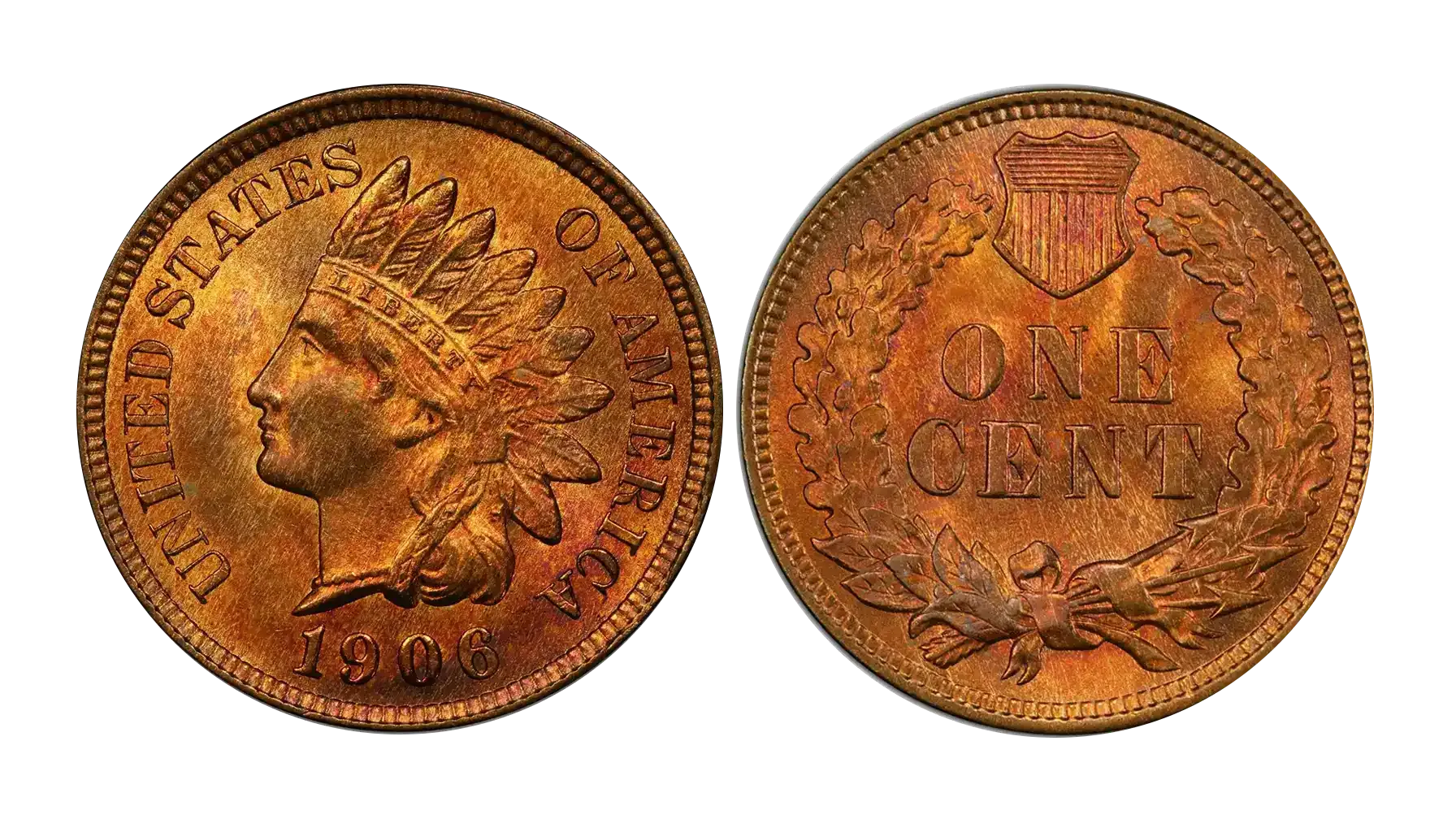
Design Elements
Obverse (Front)
A classical representation of Lady Liberty wearing a Native American war bonnet — a fusion of classical ideals and Native American imagery.
Inscription: “UNITED STATES OF AMERICA” around the rim, and the year “1906” below.
Longacre chose Liberty instead of an actual Native American figure to preserve allegorical tradition while incorporating American identity.
The headdress is historically inaccurate for an allegorical female figure but was meant to represent "American-ness", not a specific tribe.
Reverse (Back)
Central text: “ONE CENT” boldly displayed.
Surrounding motif: A laurel wreath (1859), later changed to an oak wreath with a shield (from 1860 onward, including 1906).
The shield at the top symbolized strength and unity.
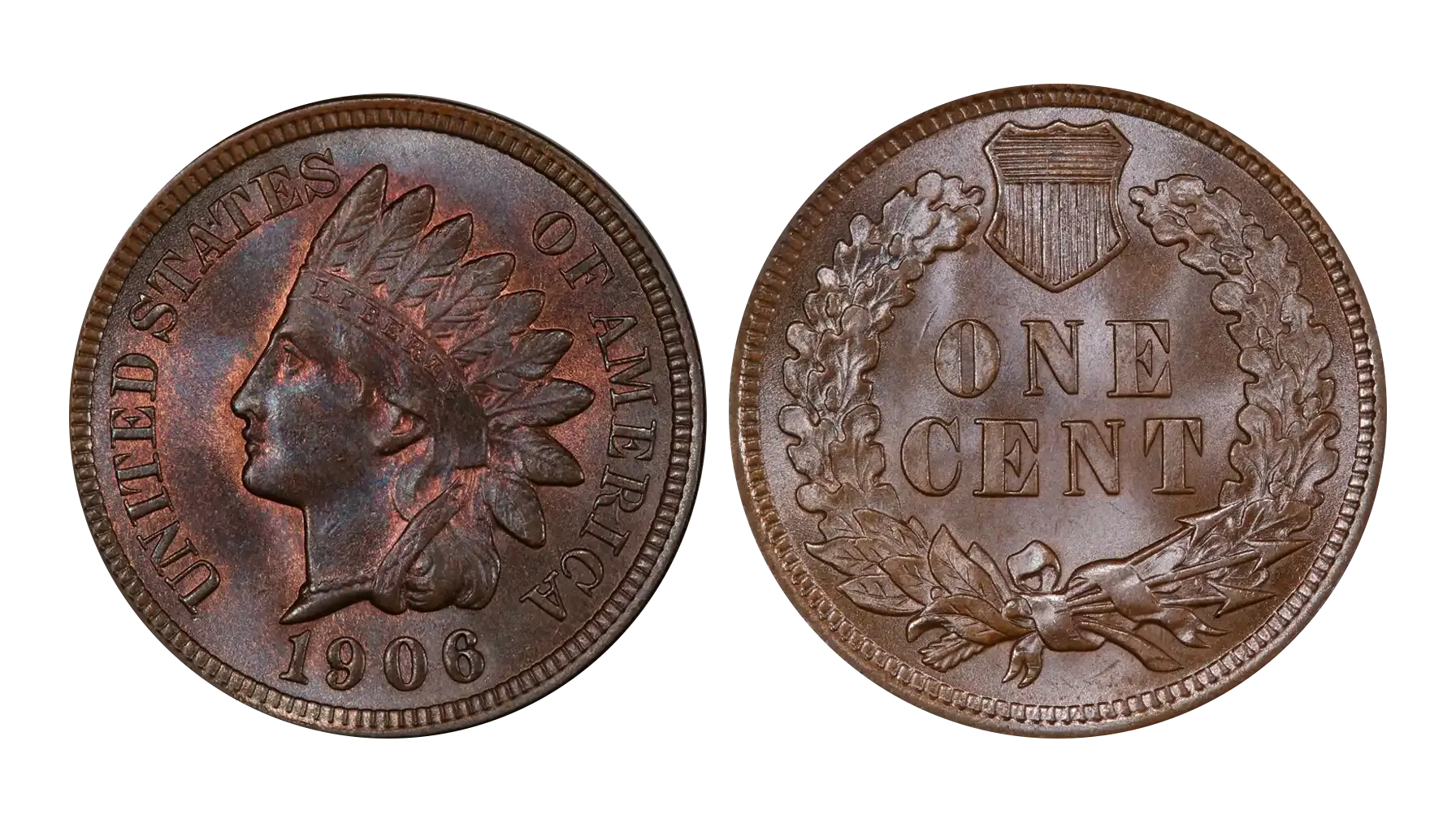
1906 Indian Head Penny Value Today (2025 Chart)
Grade | Brown (BN) | Red-Brown (RB) | Red (RD) |
Good (G-4) | $1.50 | – | – |
Very Good (VG-8) | $2.00 | – | – |
Fine (F-12) | $3.00 | – | – |
Very Fine (VF-20) | $4.00 | – | – |
Extremely Fine (EF-40) | $8.00 | – | – |
About Uncirculated (AU-50) | $18 | $22 | – |
AU-58 | $25 | $32 | – |
MS-60 | $35 | $45 | $80 |
MS-63 | $55 | $70 | $120 |
MS-64 | $80 | $100 | $180 |
MS-65 | $120 | $180 | $300–$500+ |
MS-66 | $180 | $300 | $600–$900 |
Color Designations (BN, RB, RD) are very important in Mint State coins:
BN (Brown): Fully toned brown from oxidation.
RB (Red-Brown): 30–70% original red luster.
RD (Red): 90%+ original red surfaces.
Graded coins with third-party certification (PCGS, NGC) typically sell at the high end of the ranges.
Raw coins (ungraded) often trade for 10–40% less unless visually exceptional.
1906 Indian Head Penny Errors List
Although it was mass-produced with over 96 million coins struck, a small number of mint errors and die varieties have surfaced — and some can increase the 1906 5 cent coin value.
Die Cracks and Die Cuds
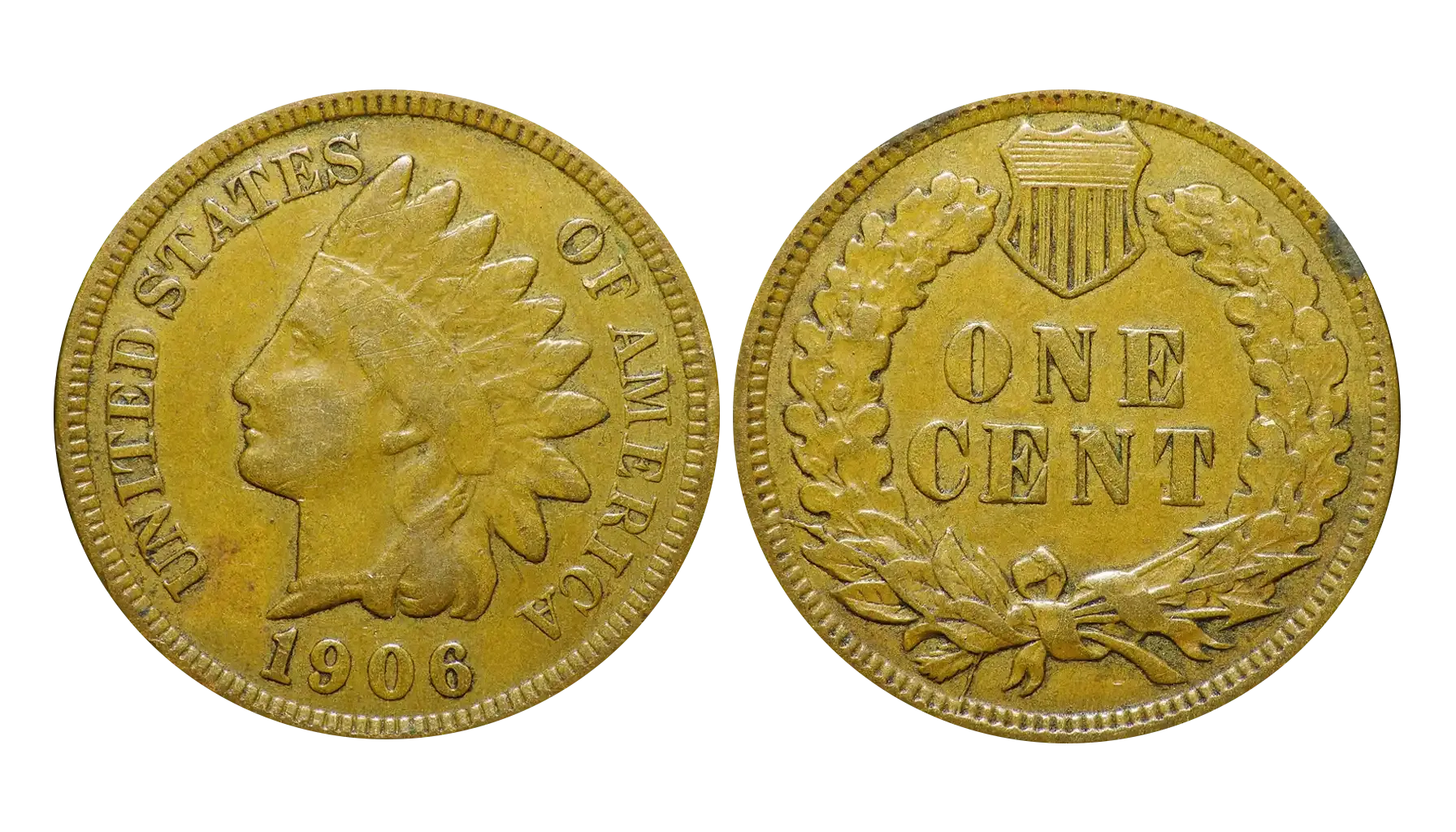
Die cracks occur when a working die develops fractures, leaving raised lines on the coin.
Cuds are formed when a piece of the die face breaks off, resulting in a blob-like raised area where no design exists.
Look for:
Raised lines across Liberty’s headband, feathers, or rim.
Rim-to-letter cracks or shield cuds on the reverse.
1906 penny value today with this error:
Size & Location | Typical Value |
Small cracks | $10 – $25 |
Prominent rim-to-rim | $30 – $75 |
Full die cud | $100 – $200+ |
High-grade 1906 cent coins with dramatic die cracks or cuds are desirable, especially if uncirculated.
Off-Center Strike
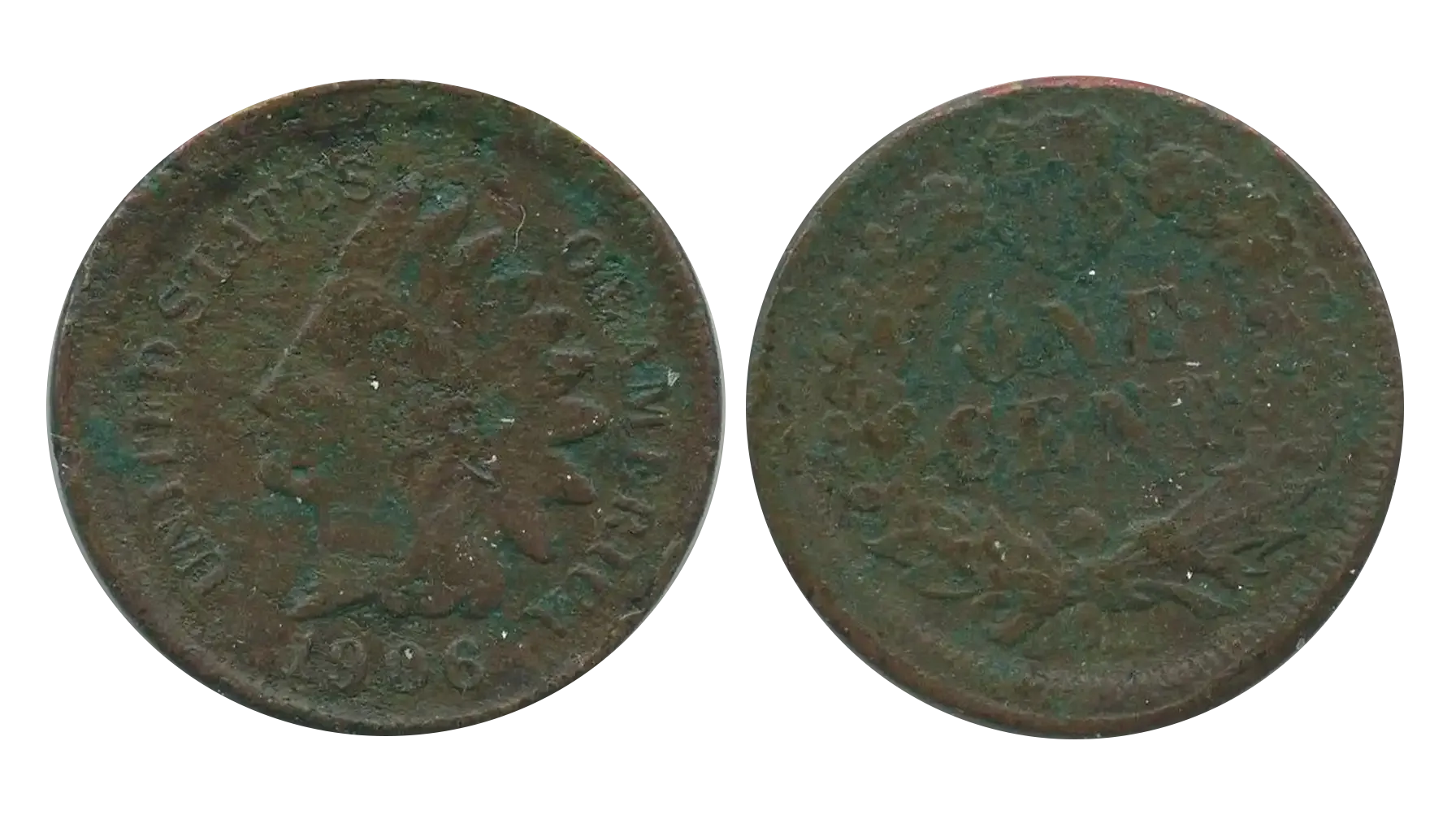
It occurs when the coin blank (planchet) is misaligned with the dies during striking, leaving part of the design missing, and influencing the total 1906 penny coin value.
Partial rim missing.
Parts of "ONE CENT" or Liberty’s face cut off.
Must retain a full visible date for strong value.
How much is a 1906 Indian head penny worth in this case?
% Off-Center | With Date Visible | Without Date |
5–10% | $20 – $50 | $5 – $15 |
15–30% | $60 – $120 | $20 – $50 |
40–60%+ | $150 – $300+ | $75 – $150 |
Double Strikes
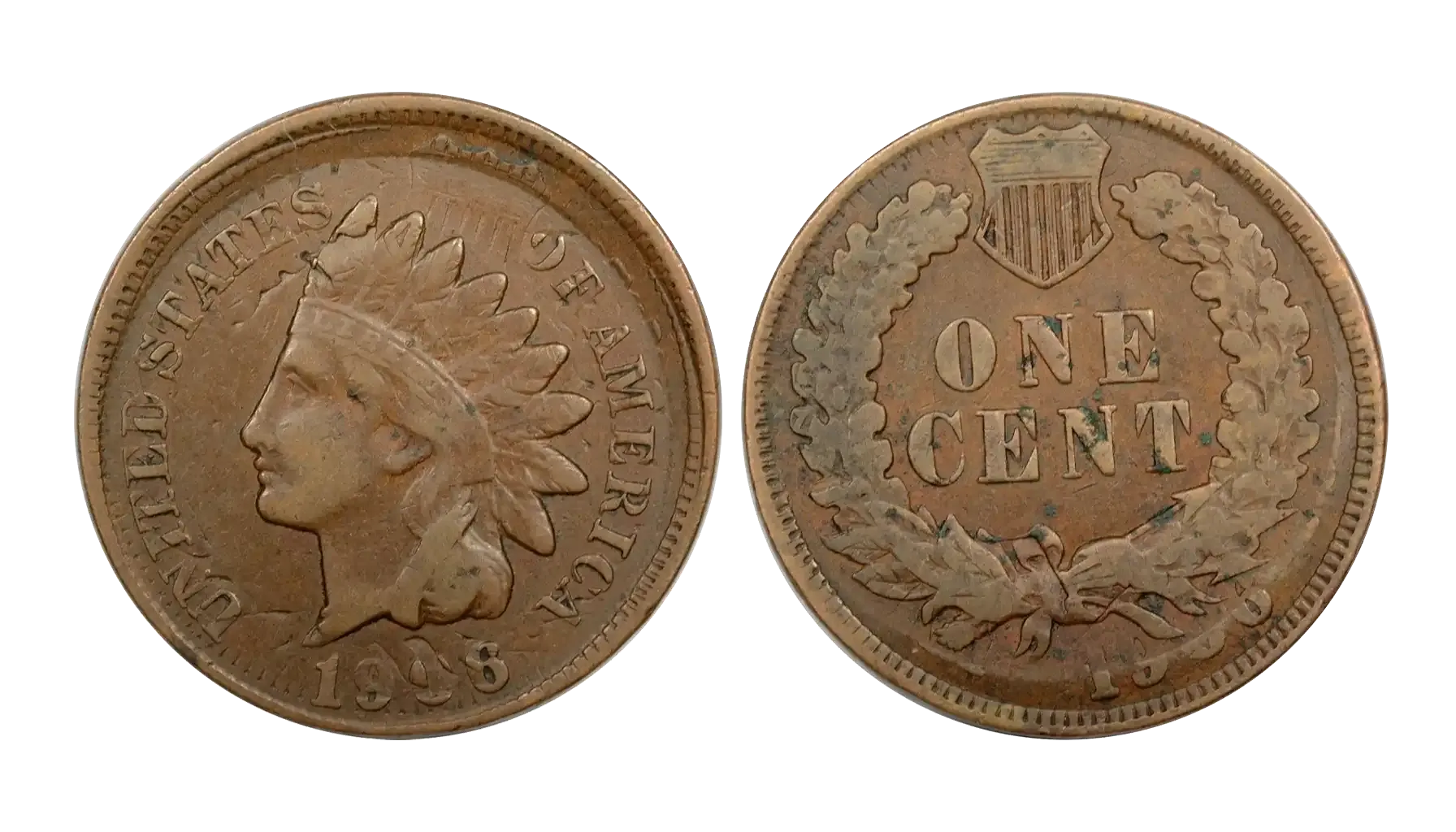
The coin is struck more than once, either in the same or a shifted position.
Types:
Same position double strike (minor shadowing).
Shifted second strike (much more valuable).
Visual Clues:
Ghosted outlines on Liberty’s profile or date.
Overlapping of "ONE CENT" or shield.
Indian Head penny 1906 value if with such an error:
Type | Value Range |
Slight same-position shift | $75 – $150 |
Significant shift (20%+) | $200 – $600+ |
Note! Seek NGC or PCGS-certified examples, as fakes exist.
Repunched Date (RPD) – Variety Error
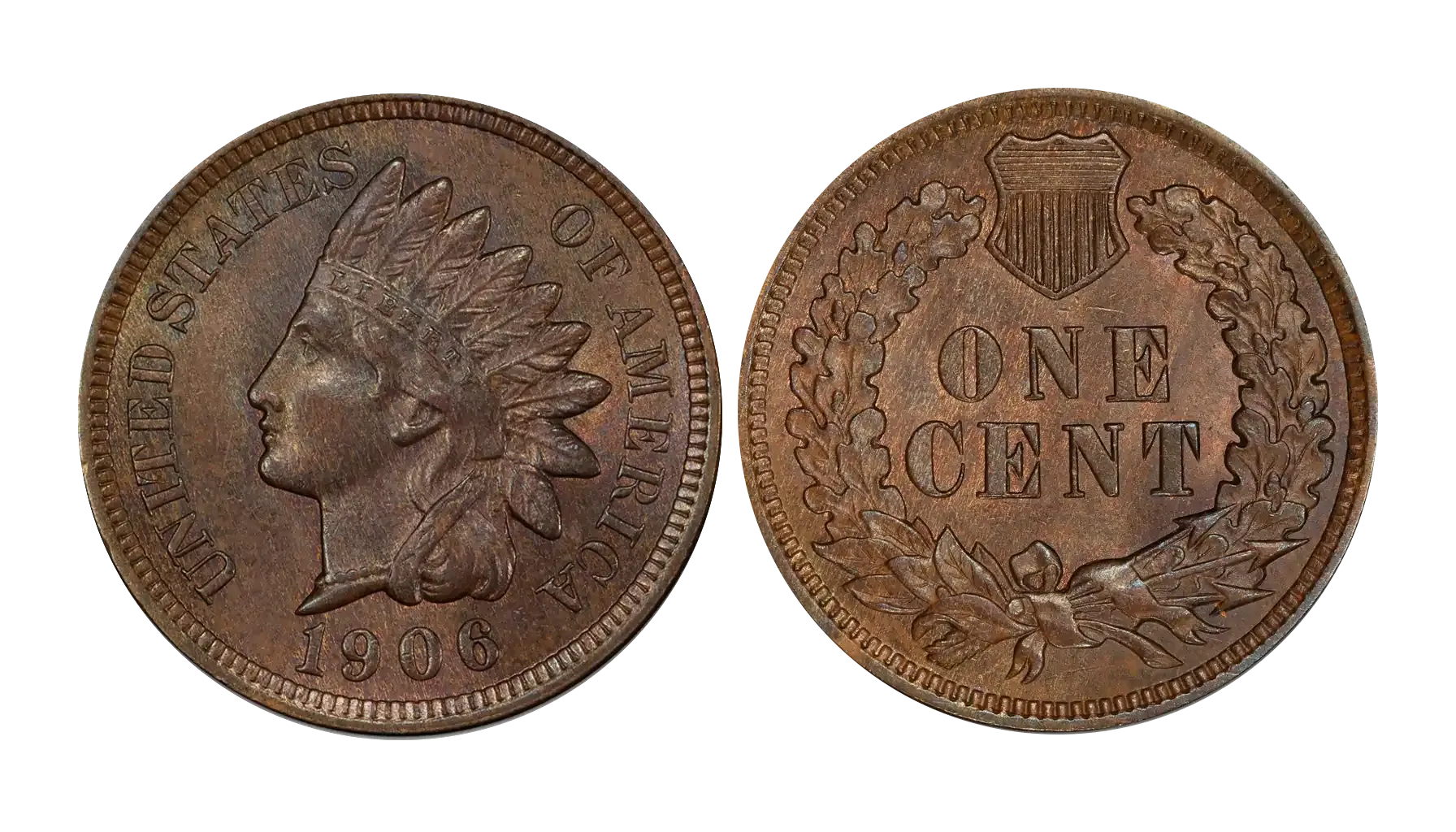
The date was punched into the working die more than once. This led to a visible doubling or misalignment of digits.
Known variety is a RPD-001 (Repunched 1 and 9) — slightly visible extra impressions beneath or beside the digits.
Where to Look: Under magnification, focus on the bottom and left side of the "1" and "9" in the date.
Estimated 1906 one cent coin value:
Condition | Typical Value |
Fine – VF | $15 – $40 |
XF – AU | $40 – $80 |
MS (Red) | $150 – $300+ |
Repunched date varieties are subtle — use 10x magnification and reference a Cherrypicker’s Guide or Variety Vista image set. You may also try to scan it with a Coin ID Scanner app.
Misaligned Die Strike (MAD)
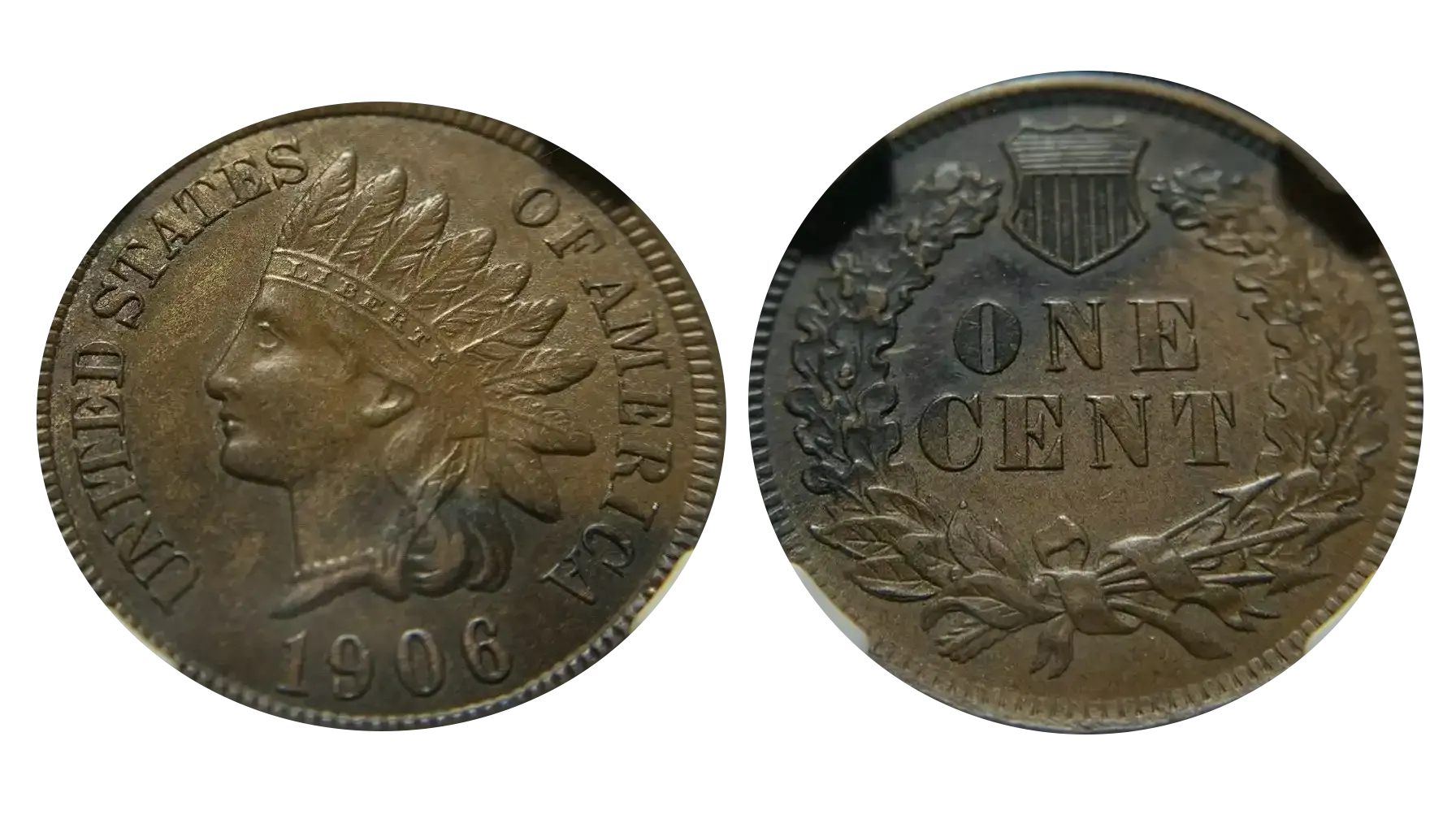
It occurs when one die (usually the obverse) is not properly aligned, pushing the design toward one edge.
One side of the rim is thicker.
The reverse appears centered.
No part of the design is missing (unlike off-center strike).
1906 Indian Head cent value range:
Severity | Estimated Value |
Mild (5%) | $5 – $15 |
Dramatic (15%) | $20 – $50+ |
Struck Through Errors
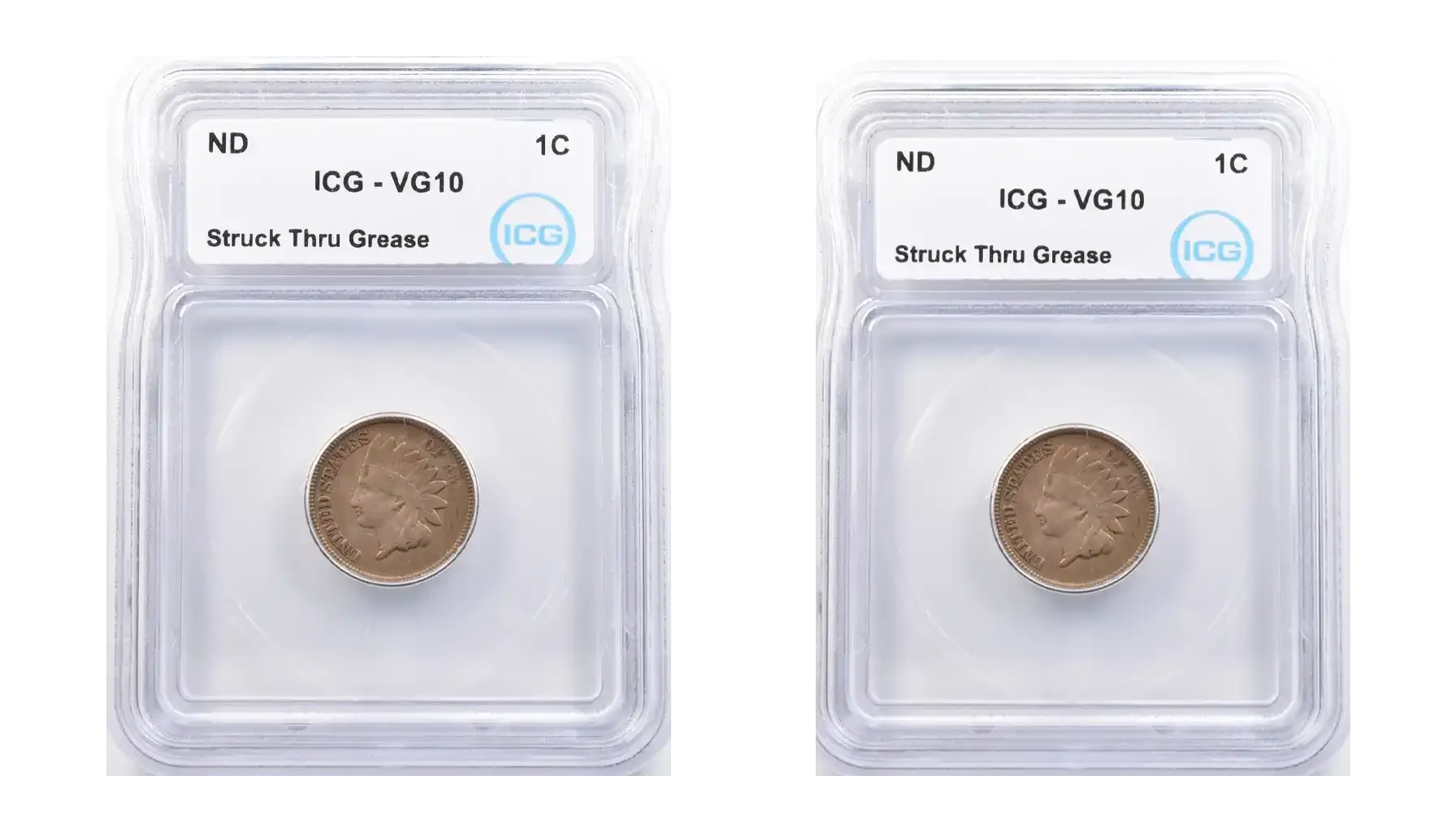
Foreign material (such as grease or cloth) gets between the die and planchet, resulting in missing or blurred areas.
Struck through grease: Soft, blurry areas, especially around LIBERTY or the shield.
Struck through cloth/wire: May leave textured impressions.
How much is an Indian Head penny from 1906 worth?
Type | Typical Value |
Minor grease-filled dies | $5 – $15 |
Major struck-through (clear shape) | $50 – $200+ |
Error is most desirable when it affects key design elements like the date, shield, or Liberty’s face.
Rarity and Collectibility
The 1906 Indian cent is not rare in circulated grades due to its high mintage of 96,020,530 coins (please don’t relate to the 1906 wheat penny value, as the word “Wheat” here is related only to Lincoln cents).
In uncirculated grades (MS-63 and above) — especially with full red (RD) luster — the 1906 penny Indian Head becomes significantly more desirable.
Proof versions were not minted in 1906; the final year for Indian Head cent proofs was 1909.
Comparative Rarity (Among Indian Head Cents):
Date | Relative Rarity | Collector Demand |
1877 | Very High | Extremely High |
1906 | Common | Moderate |
1908-S | High (first “S”) | High |
Grading Characteristics
Explanation | |
Good (G-4) | LIBERTY mostly worn off; outline of portrait visible |
Fine (F-12) | LIBERTY partially visible; facial details weak |
Very Fine (VF-20) | LIBERTY mostly visible; feathers worn but defined |
Extremely Fine | Full LIBERTY; some detail in ribbon and feathers |
AU (About UNC) | Sharp design; minimal wear on cheekbone and headdress |
MS-63 and above | No wear; full mint luster; possible red coloration |
Authentication Tips
Where is the mint mark on a 1906 Indian Head penny? All 1906 pennies were struck at the Philadelphia Mint. No mint mark appears on them — and if you see one, it’s either a damaged area, foreign matter, or a counterfeit.
Be cautious of:
Altered dates (e.g., 1906 made to look like 1909).
Artificial coloring (polished or retoned to mimic Red designation).
Counterfeits: Less common for this date, but exist — especially in higher grades that can be faked to be sold at higher value of 1906 Indian Head penny sums.
Market and Investment Potential
In low grades, the 1906 Indian Head cent is valued mostly as a type coin.
MS-65 RD and above, especially certified by PCGS or NGC, can have a one cent 1906 value $400–$900+ at auction.
Coins with rare die varieties or certified error features often exceed normal price ranges.
Sales Trend
There’s a steady demand from type set collectors and early American copper interested people.
Indian Head cents, especially in premium condition, are among the top performers in the small-cent market.
Collecting Strategy
For beginner collectors: Buy a problem-free VF to XF example for ~$10–$20.
For intermediate: Look for AU or MS-63 RB coins with strong eye appeal.
For advanced: Target MS-65 RD with CAC sticker or find attractive error specimens (off-center, RPD, etc.).
So, what is a 1906 penny worth? It depends. Yes, it’s not a rare specimen in numismatics, but it can still be a nice part of anyone’s collection with a rather affordable value of a 1906 Indian Head penny.



